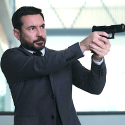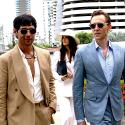The second instalment of this three-part series on the history of Spain (from the BBC in collaboration with the Open University) told a tale that is probably still relatively unfamiliar in the Anglophone world. That’s despite the fact that one of its star turns was the financing by that fervently religious 15th century Iberian power couple, Ferdinand of Aragon and Isabella of Castile, of the legendary voyage of Christopher Columbus. Their own relationship was dramatic, too: the young, ambitious and highly intelligent teenage Isabella had turned down no fewer than seven aristocratic aspirants for her hand and presciently eloped with Ferdinand, a marriage one felt that its participants must have thought was made indeed in heaven.
The historian Simon Sebag Montefiore, in a natty straw boater and bright blue shirt as is his wont, was our guide. He has a deep personal interest in the period, not least as a member of a prominent Sephardic Jewish family that extends back centuries. One of the highlights was his discovery of the fate of several ancestors who were highly placed governors in Mexico, but even so could not escape the Inquisition and were burned at the stake there.
Spain’s unity under its Catholic monarchs was characterised by faith and avarice We started with a very noisy fiesta and celebration, its flamboyant participants marking the reconquest of Spain by Ferdinand and Isabella: they managed finally to evict the remnants of the Islamic caliphates of southern Spain, Al Andalus (now Andalusia) that stretched from Seville to Granada and beyond, the climax of an intermittent 400-year Holy War. Along the way we had a visual treat, mostly supplied by the extraordinary achievements of Islamic architecture. The Giralda of Seville, now the bell tower of the cathedral, was originally a minaret. Our intrepid guide showed us its internal ramp, placed there for a tired Imam so he could go up on his donkey – rather than walk up endless steps – to fulfil his duties to call to prayer for the five times a day mandated by the Prophet. Above all we visited the Alhambra, the chief part of the great Islamic palaces of Granada, built for the dissolute and decadent Nasrid dynasty. (Sebag Montefiore looks over the rooftops of Granada from the Alhambra, pictured below.).
The site of the 1079 battle of Cabra between Granada and Seville, with Christian soldiers fighting on both sides, is now idyllic meadows; the legendary mercenary El Cid was involved here, not to mention Alfonso VI of Castile and Leon – on both sides. We were shown monuments to El Cid, who remains both an historic figure and a myth; the latest speculation assumes that he was out for himself and indeed a sword for hire, who nevertheless managed to die both wealthy and in his own bed.
Christendom had revived, we learnt, in the 11th century: Alfonso VI conquered Toledo, then a great Muslim city. By 1099 the Holy Wars had started in earnest; the First Crusade took Jerusalem, and massacred 70,000 Muslims. Not until 1248 though did a King of Castile capture Seville, while the Nasrids, concealing their weakness behind architectural grandeur, clung on in Granada until the late 15th century and the fateful success of Ferdinand and Isabella.
 The savage crushing of Al Andalus included, on the order of the Archbishop of Toledo, the destruction of a thousand years of Arabic scholarship when Granada’s great libraries were fed to the flames; the Pope had obligingly gifted one tenth of his Spanish revenues to fund Ferdinand and Isabella’s conquest. Spain’s unity under its Catholic monarchs was characterised by faith and avarice; the Inquisition set up in Seville was used to settle old scores and collect bribes, as well as to torture or possibly convert heretics.
The savage crushing of Al Andalus included, on the order of the Archbishop of Toledo, the destruction of a thousand years of Arabic scholarship when Granada’s great libraries were fed to the flames; the Pope had obligingly gifted one tenth of his Spanish revenues to fund Ferdinand and Isabella’s conquest. Spain’s unity under its Catholic monarchs was characterised by faith and avarice; the Inquisition set up in Seville was used to settle old scores and collect bribes, as well as to torture or possibly convert heretics.
Torquemada was the first head of the Tribunal of the Holy Office; between 1492 and 1530 15,000 Spaniards were tortured, 2,000 executed. 300,000 Jews were given the choice of conversion or exile with three months to leave, with eerie appropriateness on the sacred anniversary of the burning of the Temple in Jerusalem by the Romans. The converts were told to hang hams outside their doors to show that they were not keeping kosher kitchens. You couldn’t make it up.
It was a complex story, with Spain looking across the Mediterranean to North Africa, at its closest only 15 kilometres away, as well as to the north; maps helped but more captions for unfamiliar names would have been welcome aids. The unavoidable noisy portentousness of the background music was distracting (not the fault, I assume, of the composer but of the brief) since the story of Spain emerging, not only as a unified nation but also on the cusp of becoming in the 16th century the dominant military and imperial power in Europe, was quite powerful enough. The Spanish Tourist Board too should have been pleased with the gorgeous scenery and cities on view.















Add comment